
|
It brightened up to 6.2 mag in June (June 24, Marco Goiato). Now it is fading. It has already faded down to 11.7 mag (Sept. 5, Thomas Lehmann). It it not observable already in the Northern Hemisphere. In the Southern Hemisphere, it will be getting lower after this, and will be unobservable in October.
Date(TT) R.A. (2000) Decl. Delta r Elong. m1 Best Time(A, h)
Sept.10 14 21.03 -28 3.0 2.803 2.387 55 11.0 19:11 ( 79, 37)
Sept.17 14 23.46 -27 56.2 2.989 2.461 49 11.3 19:16 ( 76, 31)
|
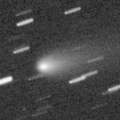
|
Now it is 11.3 mag (Sept. 1, Sandor Szabo). It is observable at 12 mag from summer to autumn, but it keeps low for some time. Juan Jose Gonzalez reported it so bright as 9.5 mag on Sept. 9.
Date(TT) R.A. (2000) Decl. Delta r Elong. m1 Best Time(A, h)
Sept.10 8 28.85 13 38.7 1.959 1.379 41 12.1 4:42 (246, 10)
Sept.17 8 49.90 11 16.4 1.952 1.395 42 12.2 4:32 (248, 11)
|
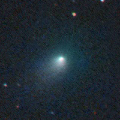
|
Now it is 12.6 mag (Aug. 20, Thomas Lehmann). It will be fading gradually after this. In the Northern Hemisphere, it keeps low for a long time after this.. In the Southern Hemisphere, it keeps observable in good condition for a long time.
Date(TT) R.A. (2000) Decl. Delta r Elong. m1 Best Time(A, h)
Sept.10 15 27.99 -22 52.4 1.664 1.588 67 12.1 19:11 ( 95, 49)
Sept.17 15 49.05 -24 34.7 1.722 1.606 66 12.3 19:16 ( 90, 47)
|
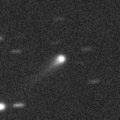
|
It brightened rapidly up to 13.4 mag (Aug. 31, Sandor Szabo). It will be observable at 12-13 mag until autumn. Juan Jose Gonzalez reported it so bright as 10.0 mag on Sept. 5.
Date(TT) R.A. (2000) Decl. Delta r Elong. m1 Best Time(A, h)
Sept.10 15 13.92 -15 22.8 2.251 2.001 62 12.4 19:11 (101, 42)
Sept.17 15 29.09 -15 47.5 2.305 1.995 59 12.3 19:16 ( 98, 39)
|
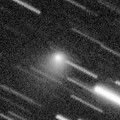
|
Now it is so bright as 11.9 mag (Sept. 9, J. P. Navarro Pina). It will be low in November, but it keeps observable in good condition for a while.
Date(TT) R.A. (2000) Decl. Delta r Elong. m1 Best Time(A, h)
Sept.10 20 10.16 20 34.8 1.089 1.885 128 12.5 20:48 (180, 35)
Sept.17 19 41.16 12 13.9 1.187 1.893 119 12.7 19:53 (180, 43)
|

|
Now it is 11.1 mag (July 31, Chris Wyatt). It is not observable now in the Northern Hemisphere. It will be unobservable soon also in the Southern Hemisphere.
Date(TT) R.A. (2000) Decl. Delta r Elong. m1 Best Time(A, h)
Sept.10 12 51.41 -3 17.5 2.522 1.673 25 12.6 19:11 ( 90, 7)
Sept.17 13 10.10 -5 11.6 2.564 1.695 23 12.8 19:16 ( 87, 5)
|

|
It brightened up to 8-9 mag from winter to spring. Now it is fading. It has already faded down to 12.9 mag (July 23, Chris Wyatt). It is not observable now. It will appear in the morning sky at 14 mag in November in the Northern Hemisphere, or in December in the Southern Hemisphere.
Date(TT) R.A. (2000) Decl. Delta r Elong. m1 Best Time(A, h)
Sept.10 12 12.56 6 14.5 4.661 3.695 14 13.1 19:11 ( 93, -7)
Sept.17 12 18.11 4 50.5 4.738 3.753 10 13.2 19:16 ( 87,-12)
|

|
Now it is 13.5 mag (Aug. 30, Jakub Cerny). It is observable in excellent condition in the Southern Hemisphere.
Date(TT) R.A. (2000) Decl. Delta r Elong. m1 Best Time(A, h)
Sept.10 19 14.94 -25 23.7 5.346 5.905 119 13.4 19:56 (180, 80)
Sept.17 19 14.77 -25 15.6 5.445 5.903 112 13.5 19:28 (180, 80)
|
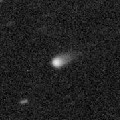
|
Now it is 13.3 mag (Sept. 5, Alan Hale). It is expected to brighten up to 7 mag in 2017 summer. In the Northern Hemisphere, it becomes low temporarily in summer, but it keeps observable in good condition until the highlight while the comet will be brightening. In the Southern Hemisphere, it is not observable until early 2017.
Date(TT) R.A. (2000) Decl. Delta r Elong. m1 Best Time(A, h)
Sept.10 10 32.46 49 56.5 4.341 3.711 45 13.6 4:42 (228,-31)
Sept.17 10 46.44 49 25.1 4.233 3.645 48 13.4 4:32 (228,-30)
|

|
It keeps unobservable for a long time. It will appear in the morning sky in December, when the comet will be fainter than 15 mag.
Date(TT) R.A. (2000) Decl. Delta r Elong. m1 Best Time(A, h)
Sept.10 10 42.02 1 33.3 2.414 1.426 8 13.5 4:42 (275,-10)
Sept.17 11 4.90 -0 33.0 2.427 1.443 8 13.5 4:32 (277, -9)
|
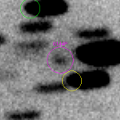
|
It became so bright as 8 mag in 2009. It was expected to brighten up to 11-12 mag from summer to autumn. But actually, it is 13.9 mag (Sept. 2, Kunihiro Shima), fainter than originally expected by 3 mag. It keeps locating low for a while. Juan Jose Gonzalez reported it so bright as 9.2 mag on Sept. 9.
Date(TT) R.A. (2000) Decl. Delta r Elong. m1 Best Time(A, h)
Sept.10 8 57.83 15 13.2 2.140 1.436 34 14.0 4:42 (249, 3)
Sept.17 9 19.81 13 23.5 2.128 1.444 36 13.9 4:32 (251, 4)
|
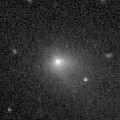
|
Now it is 13.0 mag (Sept. 1, Seiichi Yoshida). Distant object, but it keeps observable at 13-14 mag for a long time from 2015 to 2016.
Date(TT) R.A. (2000) Decl. Delta r Elong. m1 Best Time(A, h)
Sept.10 0 49.46 -0 38.2 4.008 4.944 155 14.0 1:33 (180, 56)
Sept.17 0 47.74 -1 13.9 3.983 4.952 162 13.9 1:04 (180, 56)
|
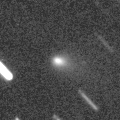
|
Now it is bright as 13.9 mag (Sept. 1, Sandor Szabo). It had been lost for a long time over 200 years since its discovery in 1783. In the Northern Hemisphere, it is observable in excellent condition from summer to winter. In the Southern Hemisphere, it keeps observable in good condition until November.
Date(TT) R.A. (2000) Decl. Delta r Elong. m1 Best Time(A, h)
Sept.10 5 10.32 9 7.3 1.462 1.777 90 14.1 4:42 (204, 43)
Sept.17 5 17.74 11 41.0 1.388 1.780 94 14.0 4:32 (200, 41)
|

|
Now it is 13.7 mag (Aug. 27, Sandor Szabo). It will be fading gradually after this. In the Northern Hemisphere, it keeps observable until early November. It becomes observable in the evening sky from July to September also in the Southern Hemisphere.
Date(TT) R.A. (2000) Decl. Delta r Elong. m1 Best Time(A, h)
Sept.10 15 26.03 21 31.8 3.603 3.273 63 14.0 19:11 (135, 19)
Sept.17 15 30.85 19 1.4 3.717 3.314 59 14.1 19:16 (128, 16)
|
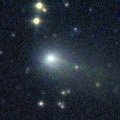
|
It brightened up to 12.5 mag in summer (Aug. 3, Marco Goiato). Now it is fading. It has already faded down to 14.0 mag (Sept. 1, Seiichi Yoshida). It keeps observable in good condition for a while.
Date(TT) R.A. (2000) Decl. Delta r Elong. m1 Best Time(A, h)
Sept.10 20 51.37 -16 42.9 1.779 2.655 143 14.3 21:32 (180, 72)
Sept.17 20 51.75 -17 2.7 1.859 2.677 136 14.4 21:05 (180, 72)
|
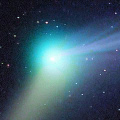
|
It brightened up to 6 mag from autumn to winter. Now it is fading. It has already faded down to 13.9 mag (Aug. 31, Jakub Cerny). It is observable in good condition in the Northern Hemisphere. It is not observable after this in the Southern Hemisphere.
Date(TT) R.A. (2000) Decl. Delta r Elong. m1 Best Time(A, h)
Sept.10 6 3.17 52 14.1 4.336 4.252 78 14.5 4:42 (198, -1)
Sept.17 6 0.17 52 59.6 4.296 4.326 85 14.5 4:32 (195, -1)
|
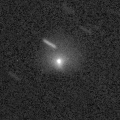
|
It has brightened in outburst up to 14 mag twice, in 2006 January and 2011 May. Third outburst occured on Aug. 28, and now it is bright as 14.8 mag (Aug. 30, Juan Jose Gonzalez). It is observable in good condition in autumn.
Date(TT) R.A. (2000) Decl. Delta r Elong. m1 Best Time(A, h)
Sept.10 1 24.75 6 44.3 5.439 6.294 145 15.1 2:08 (180, 48)
Sept.17 1 22.89 6 29.3 5.396 6.306 152 15.1 1:39 (180, 48)
|
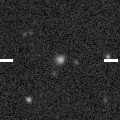
|
Now it is 16.4 mag (Aug. 12, Thomas Lehmann). It will be unobservable temporarily from summer to autumn. Then it will appear in the morning sky at 13 mag in December. It is expected to brighten up to 7 mag in 2017 spring. But it locates somewhat low at the high light.
Date(TT) R.A. (2000) Decl. Delta r Elong. m1 Best Time(A, h)
Sept.10 12 11.14 -5 7.7 4.464 3.516 17 15.2 19:11 ( 83, -1)
Sept.17 12 18.91 -5 52.3 4.413 3.440 12 15.1 19:16 ( 79, -5)
|

|
Appearing in the morning sky in the Northern Hemisphere. It keeps unobservable until October in the Southern Hemisphere.
Date(TT) R.A. (2000) Decl. Delta r Elong. m1 Best Time(A, h)
Sept.10 9 31.43 12 11.1 2.945 2.091 26 15.6 4:42 (256, -1)
Sept.17 9 46.34 11 10.1 2.927 2.109 29 15.8 4:32 (257, 0)
|
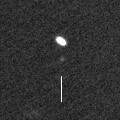
|
It is appearing in the morning sky in the Northern Hemisphere. It is expected to brighten up to 14 mag from winter to spring in 2017, and it will be observable in excellent condition in the Northern Hemisphere. In the Southern Hemisphere, it keeps extremely low until autumn, and it will be low also around the higlight.
Date(TT) R.A. (2000) Decl. Delta r Elong. m1 Best Time(A, h)
Sept.10 8 35.16 28 1.0 3.140 2.518 44 15.7 4:42 (236, -1)
Sept.17 8 49.84 27 43.6 3.066 2.503 47 15.6 4:32 (235, 0)
|
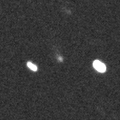
|
No observations have been reported since June. It will be unobservable after this in the Northern Hemisphere. It will be low from autumn to winter also in the Southern Hemisphere.
Date(TT) R.A. (2000) Decl. Delta r Elong. m1 Best Time(A, h)
Sept.10 12 10.65 -57 51.6 2.748 2.475 63 15.6 19:11 ( 36, 27)
Sept.17 12 41.84 -57 15.0 2.836 2.505 60 15.7 19:16 ( 37, 26)
|

|
In the Northern Hemisphere, it will be observable at 15 mag in good condition from September to October. In the Southern Hemisphere, it is not observable until November.
Date(TT) R.A. (2000) Decl. Delta r Elong. m1 Best Time(A, h)
Sept.10 10 56.59 39 54.2 0.497 0.666 35 16.7 4:42 (241,-31)
Sept.17 11 5.67 53 32.6 0.441 0.810 51 15.8 4:32 (225,-34)
|

|
It brightened up to 13.0 mag in spring (May 6, Marco Goiato). It is already unobservable in the Northern Hemisphere. In the Southern Hemisphere, it keeps observable in good condition until autumn. But it will be fading slowly after this.
Date(TT) R.A. (2000) Decl. Delta r Elong. m1 Best Time(A, h)
Sept.10 14 25.31 -32 9.2 2.836 2.467 58 16.1 19:11 ( 75, 40)
Sept.17 14 38.67 -33 11.7 2.914 2.482 55 16.2 19:16 ( 72, 37)
|
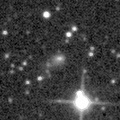
|
Now it is 16.2 mag (Aug. 31, Sandor Szabo). It will be observable at 13 mag for a long time from 2017 to 2018. In 2016, it keeps observable at 16 mag in good condition until autumn.
Date(TT) R.A. (2000) Decl. Delta r Elong. m1 Best Time(A, h)
Sept.10 18 42.25 -9 22.1 5.364 5.825 112 16.1 19:23 (180, 64)
Sept.17 18 38.72 -9 15.2 5.440 5.783 105 16.1 19:16 (166, 64)
|

|
It has been lost since its discovery in 1978. In 2016, it is expected to return in excellent condition from autumn to winter.
Date(TT) R.A. (2000) Decl. Delta r Elong. m1 Best Time(A, h)
Sept.10 19 33.01 -32 28.2 0.678 1.480 121 16.4 20:14 (180, 87)
Sept.17 19 38.90 -32 4.8 0.681 1.443 116 16.1 19:53 (180, 87)
|
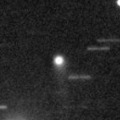
|
Now it is 15.3 mag (Sept. 1, Sandor Szabo). It will brighten up to 14 mag from summer to winter in 2017. Then it will be observable in excellent condition in the Northern Hemisphere. In the Southern Hemisphere, it is hardly observable around the highlight.
Date(TT) R.A. (2000) Decl. Delta r Elong. m1 Best Time(A, h)
Sept.10 23 51.80 -17 44.1 3.716 4.693 164 16.3 0:36 (180, 73)
Sept.17 23 44.27 -17 31.0 3.672 4.649 164 16.2 0:01 (180, 72)
|
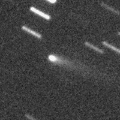
|
Now it is 15.0 mag (Sept. 1, Sandor Szabo). It will be observable at 15-16 mag in good condition from autumn to winter. It locates somewhat low in the Southern Hemisphere.
Date(TT) R.A. (2000) Decl. Delta r Elong. m1 Best Time(A, h)
Sept.10 4 25.14 29 57.0 2.198 2.542 98 16.3 4:42 (186, 25)
Sept.17 4 31.70 30 39.6 2.126 2.552 103 16.2 4:32 (184, 24)
|
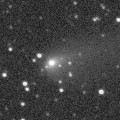
|
It was observed at 13 mag for a long time from winter to early summer. Now it is fading. It has already faded down to 16.8 mag (Aug. 16, CAO, San Pedro de Atacama). It is observable in excellent condition in the Southern Hemisphere. But it locates somewhat low in the Northern Hemisphere.
Date(TT) R.A. (2000) Decl. Delta r Elong. m1 Best Time(A, h)
Sept.10 16 17.75 -24 44.5 2.720 2.722 79 16.5 19:11 (101, 60)
Sept.17 16 27.55 -25 2.7 2.832 2.747 74 16.7 19:16 ( 96, 55)
|
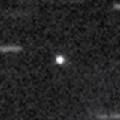
|
Now it is 16.5 mag (Aug. 25, Alexander Baransky). It will brighten up to 15 mag in winter. But it will be getting lower gradually after autumn.
Date(TT) R.A. (2000) Decl. Delta r Elong. m1 Best Time(A, h)
Sept.10 22 16.75 -11 8.3 1.404 2.389 164 16.8 22:56 (180, 66)
Sept.17 22 9.96 -10 59.4 1.391 2.346 156 16.7 22:22 (180, 66)
|

|
Now it is 15.7 mag (Aug. 25, Alexander Baransky). It keeps 16.5 mag from 2016 to 2017. It is observable in good condition in the Northern Hemisphere. In the Southern Hemisphere, it locates low in 2016, and it is not observable in 2017.
Date(TT) R.A. (2000) Decl. Delta r Elong. m1 Best Time(A, h)
Sept.10 16 33.56 33 57.8 6.392 6.276 78 16.8 19:11 (155, 16)
Sept.17 16 35.41 33 39.5 6.447 6.272 75 16.8 19:16 (149, 13)
|
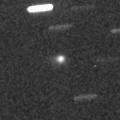
|
Now it is 16.3 mag (Aug. 31, Kunihiro Shima). It will brighten up to 13 mag and will be observable in good condition in 2017 summer. In 2016, it keeps observable until winter when it will brighten up to 15.5 mag. It locates somewhat low in the Southern Hemisphere.
Date(TT) R.A. (2000) Decl. Delta r Elong. m1 Best Time(A, h)
Sept.10 3 22.07 31 29.1 3.968 4.426 110 17.0 4:06 (180, 23)
Sept.17 3 14.44 31 37.0 3.802 4.375 118 16.8 3:31 (180, 23)
|
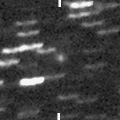
|
Now it is 16.6 mag (Aug. 4, A. Diepvens). It keeps 16-17 mag and keeps observable in good condition until autumn.
Date(TT) R.A. (2000) Decl. Delta r Elong. m1 Best Time(A, h)
Sept.10 17 46.34 -11 57.2 2.238 2.592 98 16.8 19:11 (154, 65)
Sept.17 17 52.25 -12 11.6 2.307 2.575 93 16.8 19:16 (141, 62)
|
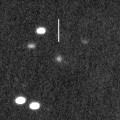
|
Now it is 18.5 mag (Aug. 11, CAO, San Pedro de Atacama). It will be observable at 16 mag in good condition from autumn to winter. It locates low in the Southern Hemisphere.
Date(TT) R.A. (2000) Decl. Delta r Elong. m1 Best Time(A, h)
Sept.10 6 57.15 24 7.9 4.235 3.908 64 17.0 4:42 (222, 17)
Sept.17 7 3.59 24 6.5 4.130 3.899 69 16.9 4:32 (220, 19)
|
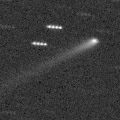
|
It brightened up to 15 mag from late 2014 to early 2016. Now it is fading slowly. Now it is 16.1 mag (Aug. 16, D. Buczynski). In the Northern Hemisphere, it will be observable at 16-17 mag in autumn in good condition. It locates extremely low in the Southern Hemisphere.
Date(TT) R.A. (2000) Decl. Delta r Elong. m1 Best Time(A, h)
Sept.10 22 33.11 44 5.9 4.470 5.177 130 17.0 23:12 (180, 11)
Sept.17 22 21.10 43 35.2 4.496 5.210 130 17.0 22:33 (180, 11)
|
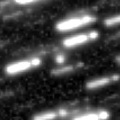
|
Now it is 16.9 mag (July 30, Yasukazu Ikari). It will brighten up to 16 mag and will be observable in good condition in 2017. In 2016, it is observable in excellent condition in the Southern Hemisphere, but it keeps low in the Northern Hemisphere.
Date(TT) R.A. (2000) Decl. Delta r Elong. m1 Best Time(A, h)
Sept.10 18 38.92 -36 45.4 2.715 3.201 109 17.1 19:20 ( 0, 88)
Sept.17 18 41.81 -36 6.8 2.788 3.184 103 17.1 19:16 ( 74, 86)
|
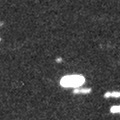
|
Now it is 17.5 mag (Aug. 4, Toshiyuki Takahashi). It will brighten up to 15 mag and will be observable in good condition from autum to winter in 2017. In the Northern Hemisphere, it keeps observable in good condition for a long time while the comet will be brightening. It is not observable until 2017 summer in the Southern Hemisphere.
Date(TT) R.A. (2000) Decl. Delta r Elong. m1 Best Time(A, h)
Sept.10 5 13.75 57 48.0 5.668 5.685 85 17.3 4:42 (190, -4)
Sept.17 5 9.38 58 15.9 5.525 5.649 91 17.2 4:32 (187, -4)
|
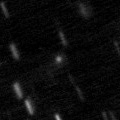
|
Now it is 18.0 mag (July 24, CAO, San Pedro de Atacama). It keeps 17 mag for a long time in 2016, and it will be observable in excellent condition in the Southern Hemisphere. It is hardly observable in the Northern Hemisphere.
Date(TT) R.A. (2000) Decl. Delta r Elong. m1 Best Time(A, h)
Sept.10 2 27.69 -50 32.4 2.970 3.570 119 17.3 3:12 ( 0, 75)
Sept.17 2 7.93 -51 28.9 2.959 3.592 121 17.4 2:24 ( 0, 74)
|
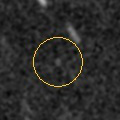
|
First return of a new periodic comet discovered in 2007. Now it is 19.4 mag (Sept. 1, K. Sarneczky, P. Szekely). It was expected to brighten up to 16.5 mag and will be observable in good condition from autumn to winter. But actually, it is fainter than predicted by 1.5 mag.
Date(TT) R.A. (2000) Decl. Delta r Elong. m1 Best Time(A, h)
Sept.10 3 35.77 -10 10.3 1.962 2.556 115 17.5 4:19 (180, 65)
Sept.17 3 39.39 -10 47.4 1.875 2.530 119 17.4 3:55 (180, 66)
|
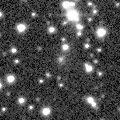
|
It will pass the perihelion in 2019. However, it has not been brightening since the discovery in 2010. Now it is 18.1 mag (Aug. 10, D. Buczynski). It keeps observable in excellent condition in the Northern Hemisphere. It is not observable in the Southern Hemisphere.
Date(TT) R.A. (2000) Decl. Delta r Elong. m1 Best Time(A, h)
Sept.10 4 43.45 56 35.2 9.890 9.943 90 17.5 4:42 (186, -2)
Sept.17 4 44.01 57 11.8 9.775 9.922 95 17.4 4:32 (184, -2)
|

|
It brightened up to 13-14 mag from 2014 to 2015. Now it is fading. It has already faded down to 17.0 mag (Aug. 12, iTelescope Observatory, Siding Spring). It will be fainter than 18 mag in October.
Date(TT) R.A. (2000) Decl. Delta r Elong. m1 Best Time(A, h)
Sept.10 23 11.02 -5 47.7 4.727 5.734 178 17.5 23:51 (180, 61)
Sept.17 23 8.35 -6 12.9 4.783 5.779 171 17.6 23:21 (180, 61)
|
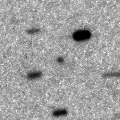
|
Now it is 17.9 mag (Aug. 25, Alexander Baransky). It will be observable at 17.5 mag in good condition in autumn.
Date(TT) R.A. (2000) Decl. Delta r Elong. m1 Best Time(A, h)
Sept.10 23 5.64 4 6.4 1.575 2.574 170 17.6 23:45 (180, 51)
Sept.17 23 1.49 3 41.1 1.554 2.547 168 17.5 23:14 (180, 51)
|
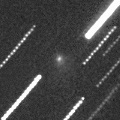
|
Now it is 17.9 mag (Aug. 8, J. Gonzalez). It keeps 17-18 mag until autumn. It keeps observable in excellent condition in the Northern Hemisphere. It will be getting lower gradually in the Southern Hemisphere.
Date(TT) R.A. (2000) Decl. Delta r Elong. m1 Best Time(A, h)
Sept.10 19 18.29 37 32.0 1.834 2.386 110 17.6 19:58 (180, 17)
Sept.17 19 3.51 37 3.9 1.940 2.409 105 17.8 19:16 (180, 18)
|
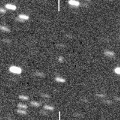
|
First return of a new periodic comet discovered in 2008. Now it is 18.8 mag (Aug. 1, M. Jaeger, E. Prosperi, S. Prosperi, W. Vollmann). It keeps observable at 17.5 mag until autumn.
Date(TT) R.A. (2000) Decl. Delta r Elong. m1 Best Time(A, h)
Sept.10 20 3.54 -19 22.9 2.324 3.084 131 17.6 20:44 (180, 74)
Sept.17 20 3.66 -19 20.7 2.395 3.080 124 17.7 20:17 (180, 74)
|
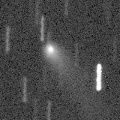
|
It was observed at 14-15 mag from 2014 to 2015. Now it is fading. It has already faded down to 17.3 mag (Aug. 10, D. Buczynski). In the Northern Hemisphere, it keeps observable in excellent condition until winter when the comet will be fainter than 18 mag. It is not observable in the Southern Hemisphere.
Date(TT) R.A. (2000) Decl. Delta r Elong. m1 Best Time(A, h)
Sept.10 4 51.85 77 1.9 5.964 5.986 86 17.6 4:42 (183,-22)
Sept.17 4 56.19 78 15.0 5.944 6.027 89 17.7 4:32 (182,-23)
|
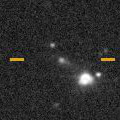
|
It is 16.8 mag now (Aug. 31, Kunihiro Shima). It was expected to brighten up to 16 mag and observable in good condition in autumn. But actually, it is fainter than originally predicted.
Date(TT) R.A. (2000) Decl. Delta r Elong. m1 Best Time(A, h)
Sept.10 22 54.05 -11 59.9 1.787 2.786 171 17.7 23:34 (180, 67)
Sept.17 22 48.79 -11 59.4 1.788 2.769 164 17.7 23:01 (180, 67)
|
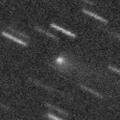
|
It became brighter than expected, brightened up to 15.1 mag from June to July (June 14, Hidetaka Sato). Now it is fading rapidly. It has already faded down to 18.9 mag (Sept. 1, Kunihiro Shima). In the Northern Hemisphere, it is observable in excellent condition. It locates low in the Southern Hemisphere.
Date(TT) R.A. (2000) Decl. Delta r Elong. m1 Best Time(A, h)
Sept.10 6 18.42 25 26.5 1.622 1.646 73 17.7 4:42 (214, 21)
Sept.17 6 33.06 26 56.7 1.598 1.685 76 18.0 4:32 (212, 20)
|
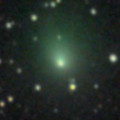
|
It brightened up to 10 mag in 2015 autumn. Now it is fading. It has already faded down to 17.8 mag (Aug. 26, Alexander Baransky). It will be fainter than 18 mag soon.
Date(TT) R.A. (2000) Decl. Delta r Elong. m1 Best Time(A, h)
Sept.10 3 40.39 13 48.7 2.621 3.131 111 17.8 4:24 (180, 41)
Sept.17 3 39.99 13 36.7 2.567 3.169 118 17.9 3:56 (180, 41)
|
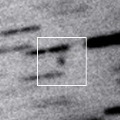
|
Now it is 17.4 mag (July 2, G. Gunn, G. W. Christie). It keeps observable at 17.5 mag in good condition from spring to autumn in the Southern Hemisphere. It is not observable in the Northern Hemisphere.
Date(TT) R.A. (2000) Decl. Delta r Elong. m1 Best Time(A, h)
Sept.10 17 46.76 -57 17.6 4.716 4.967 98 17.8 19:11 ( 15, 67)
Sept.17 17 52.29 -56 27.2 4.800 4.967 93 17.9 19:16 ( 24, 66)
|
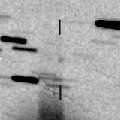
|
First return of a new periodic comet discovered in 2005. Now it is 18.9 mag (Aug. 28, K. Sarneczky, P. Szekely). In the Northern Hemisphere, it will be observable at 17 mag in excellent condition in winter. It locates somewhat low in the Southern Hemisphere.
Date(TT) R.A. (2000) Decl. Delta r Elong. m1 Best Time(A, h)
Sept.10 3 51.66 23 32.2 2.384 2.842 106 17.9 4:35 (180, 31)
Sept.17 3 55.79 23 46.7 2.296 2.837 112 17.8 4:12 (180, 31)
|
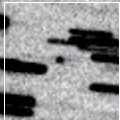
|
Now it is 17.6 mag (Aug. 6, iTelescope SRO Observatory, Auberry). In the Northern Hemisphere, it will be observable at 17 mag in excellent condition in winter. It locates low in the Southern Hemisphere.
Date(TT) R.A. (2000) Decl. Delta r Elong. m1 Best Time(A, h)
Sept.10 6 30.27 31 13.4 3.590 3.401 71 17.9 4:42 (213, 15)
Sept.17 6 38.73 31 22.7 3.495 3.397 76 17.8 4:32 (211, 16)
|
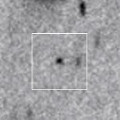
|
Now it is 19.3 mag (Aug. 31, Kunihiro Shima). It will pass the perihelion on Mar. 10, 2017. In the Northern Hemisphere, it keeps observable in the evening sky until late February while the comet will be brightening up to 8.5 mag. In the Southern Hemisphere, it will appear in the morning sky in late March at 8 mag, then it keeps observable while the comet will be fading.
Date(TT) R.A. (2000) Decl. Delta r Elong. m1 Best Time(A, h)
Sept.10 0 52.23 16 13.3 1.689 2.597 147 18.1 1:36 (180, 39)
Sept.17 0 42.92 15 56.2 1.588 2.539 155 17.8 1:00 (180, 39)
|
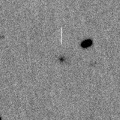
|
First return of a new periodic comet which brightened up to 16.5 mag in 2008. The condition of this apparition is very good. It was expected to brighten up to 15.5 mag in autumn and will be observable in good condition. But actually, it is 17.4 mag (Aug. 31, Kunihiro Shima), fainter than originally expected by 2-3 mag.
Date(TT) R.A. (2000) Decl. Delta r Elong. m1 Best Time(A, h)
Sept.10 0 6.37 -14 49.6 1.378 2.362 163 17.9 0:51 (180, 70)
Sept.17 23 58.27 -14 4.1 1.360 2.351 167 17.9 0:15 (180, 69)
|
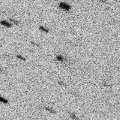
|
Now it is 17.0 mag (Aug. 31, Kunihiro Shima). It is observable at 18 mag in excellent condition in autumn.
Date(TT) R.A. (2000) Decl. Delta r Elong. m1 Best Time(A, h)
Sept.10 1 40.88 8 38.6 1.765 2.625 140 17.9 2:25 (180, 46)
Sept.17 1 38.50 8 33.8 1.730 2.639 148 17.9 1:55 (180, 46)
|
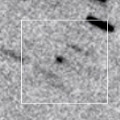
|
Now it is 18.6 mag (Aug. 31, Kunihiro Shima). It is observable at 18 mag in excellent condition in autumn.
Date(TT) R.A. (2000) Decl. Delta r Elong. m1 Best Time(A, h)
Sept.10 1 12.47 4 1.3 1.670 2.586 149 17.9 1:56 (180, 51)
Sept.17 1 9.23 3 50.1 1.641 2.594 156 17.9 1:26 (180, 51)
|
|
![]()
 77P/Longmore
77P/Longmore C/2015 O1 ( PanSTARRS )
C/2015 O1 ( PanSTARRS ) D/1978 R1 ( Haneda-Campos )
D/1978 R1 ( Haneda-Campos ) C/2016 N4 ( MASTER )
C/2016 N4 ( MASTER ) 56P/Slaughter-Burnham
56P/Slaughter-Burnham 116P/Wild 4
116P/Wild 4 93P/Lovas 1
93P/Lovas 1 C/2014 OE4 ( PanSTARRS )
C/2014 OE4 ( PanSTARRS ) C/2015 VL62 ( Lemmon-Yeung-PanSTARRS )
C/2015 VL62 ( Lemmon-Yeung-PanSTARRS ) 219P/LINEAR
219P/LINEAR 74P/Smirnova-Chernykh
74P/Smirnova-Chernykh C/2014 A4 ( SONEAR )
C/2014 A4 ( SONEAR ) 47P/Ashbrook-Jackson
47P/Ashbrook-Jackson C/2015 V1 ( PanSTARRS )
C/2015 V1 ( PanSTARRS ) C/2015 B2 ( PanSTARRS )
C/2015 B2 ( PanSTARRS ) P/2016 R1 ( Catalina )
P/2016 R1 ( Catalina ) C/2010 U3 ( Boattini )
C/2010 U3 ( Boattini ) C/2012 F3 ( PanSTARRS )
C/2012 F3 ( PanSTARRS ) 343P/2016 P3 ( NEAT-LONEOS )
343P/2016 P3 ( NEAT-LONEOS ) C/2016 K1 ( LINEAR )
C/2016 K1 ( LINEAR ) 340P/2016 N2 ( Boattini )
340P/2016 N2 ( Boattini ) C/2014 N3 ( NEOWISE )
C/2014 N3 ( NEOWISE ) 188P/LINEAR-Mueller
188P/LINEAR-Mueller 146P/Shoemaker-LINEAR
146P/Shoemaker-LINEAR 22P/Kopff
22P/Kopff C/2015 H2 ( PanSTARRS )
C/2015 H2 ( PanSTARRS ) P/2016 Q1 ( Read )
P/2016 Q1 ( Read ) P/2015 TP200 ( LINEAR )
P/2015 TP200 ( LINEAR ) 2P/Encke
2P/Encke 338P/2016 N1 ( McNaught )
338P/2016 N1 ( McNaught ) 341P/2016 N3 ( Gibbs )
341P/2016 N3 ( Gibbs ) 208P/McMillan
208P/McMillan![]()



















































